Small Spiny Lizards Found in California


| Western Fence Lizards and Sagebrush Lizards | ||
These two species of lizards are very hard to tell apart from a distance. Both are small, diurnal, brownish or grayish lizards patterned with spots and chevrons and stripes on the back that are about the same size. The pictures below might help you differentiate one from the other where they occur together, especially if you can get a male lizard in hand. In many areas of the state, Common Sagebrush Lizards are typically found only at high elevations, while Western Fence Lizards are found at low and high elevations. Click the link directly below to see a more detailed comparison. |
||
| Differences Between Western Fence Lizards and Sagebrush Lizards in California | ||
| Western Fence Lizard - Sceloporus occidentalis | ||
| This is one of the most commonly-seen lizards in California. Found in a variety of habitats throughout the state, except most desert areas, it is active during daylight. Frequently seen standing on top of rocks, boulders, fences, walls, beach driftwood, trees, as well as on the ground. Often found around suburban houses and yards. Looking at the underside of males is a good way to differentiate this species from the Sagebrush Lizard. The rear of the limbs are orange or yellow on the Fence Lizard, but not on the Sagebrush Lizard, and scales on the rear of the thighs are large and keeled. Also, the male has a more solid blue patch on the throat. |
||
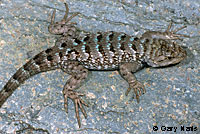 |
 |
 |
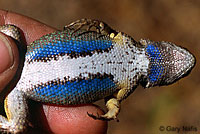 |
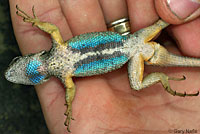 |
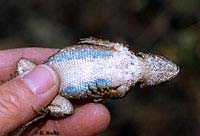 |
| Male | Male | Female |
 |
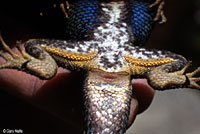 |
|
| Sometimes fence lizards are very dark before they have warmed up in the sun, like this one. They can look like they're completely black at a distance. © Dylan Gross |
Ventral view of male Western Fence Lizard, showing yellow on rear of thighs. | |
| Researchers are finding that the traditional taxonomy of Sceloporus occidentalis is incorrect, therefore many herpetologists do not currently break the species down into subspecies. The range map below is one interpretation of the distribution of the currently-recognized subspecies (and S. becki which has been elevated to a distinct species), based mostly on Ryan Calsbeek's distribution map. |
||
 |
||
| Range: Bright Green: Sceloporus becki - Island Fence Lizard Light Blue: Sceloporus occidentalis biseriatus - San Joaquin Fence Lizard Blue: Sceloporus occidentalis bocourtii - Coast Range Fence Lizard Orange: Sceloporus occidentalis longipes - Great Basin Fence Lizard Red: Sceloporus occidentalis occidentalis - Northwestern Fence Lizard Dark Gray: Sceloporus occidentalis taylori - Sierra Fence Lizard |
||
| Sagebrush Lizards - Sceloporus graciosus and Sceloporus vandenburgianus | ||
| Sagebrush lizards are generally found at higher-elevations, than Fence Lizards, including the Great Basin sagebrush zones, but they also enter river bottoms in the coastal redwoods on the north coast. They are often seen on the ground, where they will run into bushes or rocks to hide. They are also found on large rocks in the mountains. Looking at the underside of males is a good way to differentiate this species from the Western Fence Lizard. The rear of the limbs are not orange or yellow, as they are on the Western Fence Lizard, and the scales on the rear of the thighs are granular, not keeled. The blue throat patch on the male generally has light flecks. There is usually some rusty coloring on the sides of the neck and body, and a black bar on the shoulder. Here is a chart showing some differences in scale count and pattern between Sagebrush Lizards in California. |
||
 |
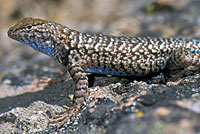 |
 |
| Female | Male | Rusty coloring behind front legs |
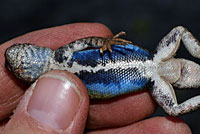 |
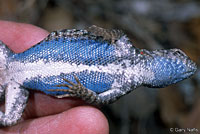 |
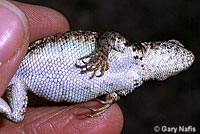 |
| Male underside | Male underside | Female underside |
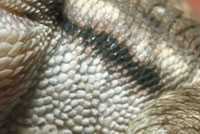 |
||
| Close-up of the granular scales on the rear thigh of a Common Sagebrush Lizard. Compare with the Western Fence Lizard |
||
| Range: Red: Sceloporus graciosus graciosus - Northern Sagebrush Lizard Orange: Sceloporus graciosus gracilis - Western Sagebrush Lizard Blue: Sceloporus vandenburgianus - Southern Sagebrush Lizard |
||
Return to the Top
© 2000 -

